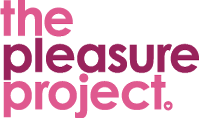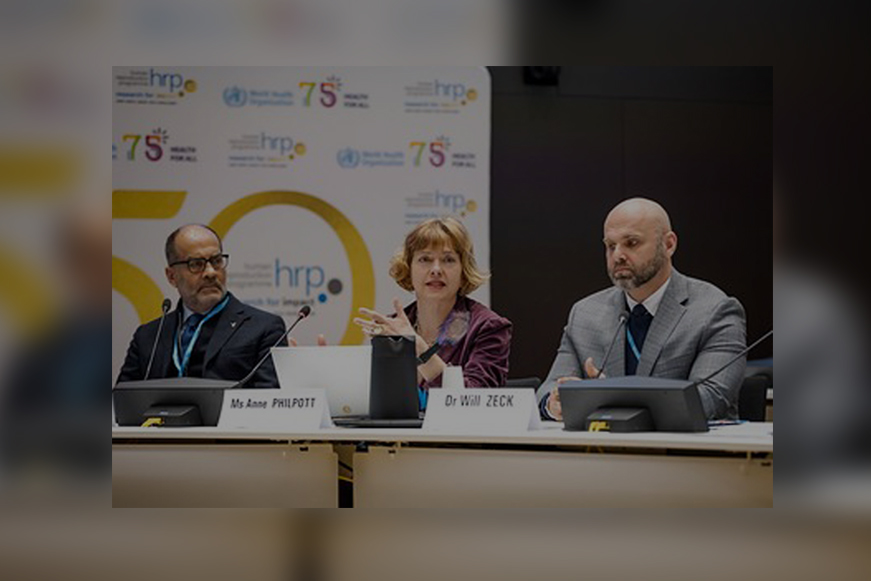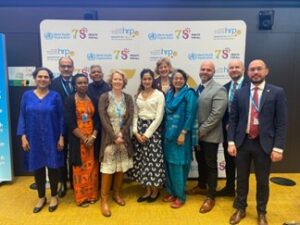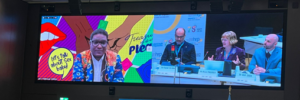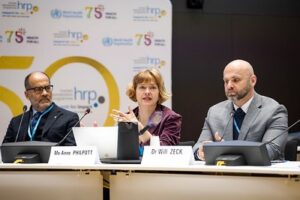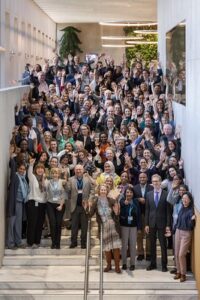Glass half full, glass half empty – The Pleasure Project’s panel at HRP50
On the 27th of April, The Pleasure Project stepped into WHO headquarters in Geneva. We were invited to the 50th anniversary of HRP (the UNDP/UNFPA/UNICEF/WHO/World Bank Special Programme of Research, Development and Research Training in Human Reproduction), the main instrument within the United Nations system for research in human reproduction, bringing together different actors to work on priorities for research to improve sexual and reproductive health.
After years of advocacy on the ground, we felt ready, empowered, and competent to step into these rooms and take a seat at the table. Our co-director Anne spoke on the panel about pleasure-inclusive interventions in SRHR together with Dr. Faysal El Kek, obstetrician, public health practitioner, researcher, and advocate in women health, and Dr. Will Zeck Chief, Sexual and Reproductive Health and Rights at the UNFPA (United Nations Population Fund) and Mahmoud Garga, Communications and Advocacy Lead at IPPF Africa Region – and got to highlight in her speech not only the work that The Pleasure Project and pleasure activists all over the world have been doing on the ground, unpaid, and in resource-scarce settings for years, but she also presented concrete evidence showing that pleasure inclusive sexual health improves sexual health outcomes – the global systematic review done in collaboration with HRP to the over 100 examples on our Global Mapping of Pleasure of how to implement a pleasure-based approach, to The Pleasure Principles, an operational guideline that people can action.
This was an historical moment for The Pleasure Project, and we could not be prouder. Seeing pleasure represented and received with curiosity but also enthusiasm gives us hope for a future where pleasure stigma is completely erased. As we said during the session: “Its not frivolous, pleasure saves lives”.
Here is a delicious extract from Anne’s panel, enjoy!
On what a pleasure inclusive SRHR intervention looks like and why is it useful from a public health perspective
“Simply, pleasure inclusive approach requires flipping the narrative to what we want in our sex and relationship lives, as I often say how can we know what we don’t want if we don’t have the opportunities to decide what we want? When we teach people how to drive a car or learn to cook, we tell them about how these basic life skills will open great opportunities but also carry risks. People should learn about both. Rather than only being taught through fear or shame. But if you think about your sex education it was likely to focus on motivation through fear and what to stop. I know my biology teacher at my all-girls college scared me completely in mine.
And yet, good safe sex with someone or alone can be good for your health, can reduce heart disease, can improve mental health and immune function so we should stop focusing only on death, danger and disease in public health and sex education. Arguably a key reason people have sex is for pleasure, to bond and hopefully flourish but most narratives in public health have managed to remove pleasure from sex.
We now know that pleasure inclusive sexual health improves sexual health outcomes. HRP and The Pleasure Project completed a global systematic review of the evidence over the past 15 years, covering all experimental trials and research that hoped to impact on SRHR outcomes and compared those that included pleasure considerations to those that implemented the usual type of risk reduction, ill-health prevention SRHR interventions Sexual health that we are used to.
We really isolated what difference including pleasure makes. Some examples were talking about condoms in a pleasurable way or helping people consider how their relationship lives could be positive. We found that including even a little bit of pleasure made a significant positive difference to sexual health outcomes, and in a meta-analysis we showed that condom use went up when the intervention was pleasure inclusive.
The results and effect size were really big for a health behavior change intervention. There has been a huge global interest in this study – with over 60 media stories across the world. All of it is positive. This new evidence-based practise doesn’t require a new infrastructure or new health delivery systems but is simply about increasing our comfort with these conversations – if this was a new drug or vaccine with these types of results, we would be calling for its immediate implementation.
The next question is how to implement this, we have mapped over 100 examples of people who are doing just that on our website. We have used this evidence to create operational guidelines or Pleasure Principles that people can put into action at work. And it happens sometimes where you don’t expect it – last year discussions of pleasure was included in the curricula and training for midwives in DRC giving midwives confidence to talk to their clients in post-natal care who they are sharing very close and trusted experiences. There are many more examples of how to integrate considerations of pleasure with different groups around the world.”
Addressing the difficulty of sustained funding and support around sexual pleasure and sexual wellbeing in public health
“Indeed, it’s true funding pleasure has been slow, there is a stigma attached to pleasure inclusive approaches. Pleasure activists often do this work unpaid, and yet its evidence based, it has an impact.
Many have been calling for their sex education to be more relevant. This becomes more urgent when we think about the access to explicit online information at the touch of a mobile phone. We need to be honest in our messaging and get support for that.
As one sex education teacher said to us in Ghana: “I tell young people sex is sweet at the right time, because if I tell them sugar is bad for them and then they taste how sweet it is, they won’t believe everything else I say”. So, Donors and Ministries also need to follow the evidence and asks of communities to fund pleasure and well-being focused sexual health programmes and not just where they think it’s appropriate – but where people ask for it.
Young people in Southern Africa have told us that talking about love and pleasure made them feel listened to and more able to navigate their dreams and romantic hopes.
If we had taken pleasure seriously at the beginning of the AIDS epidemic, we would have saved significantly more lives.
Furthermore, gender empowerment can focus on well-being and joy, rather than only reducing harm. It’s a more complete view of someone’s life. It’s actually centering empowerment on the whole person’s life and hopes.
I ask all of you this question – how many times in your life have you had sex to reproduce – and yet the vast majority of interventions and research focus on fertility reduction.”
On what we would change about the SRHR field
“That we stop fearing pleasure and silencing it. I find it bizarre that we manage to avoid it so successfully in sexual health – that we have managed to delink sex and pleasure. And now given available evidence, that pleasure inclusive sexual health significantly improves sexual health outcomes. We need to adjust all SRHR inventions to incorporate pleasure and well-being, in a way that works for the people it’s aiming to serve.
I see this as the start to talking about how relationships can enhance our lives, about that dignity.
It is time to take pleasure seriously.”
Overall, the pleasure perspective was well received and the opportunities for sexual health clear. We hope to continue partnering with HRP and WHO to advance the inclusion of pleasure and well-being and overall asset framing for sexual health in the next 5 decades of their work.
